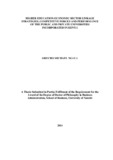| dc.description.abstract | The heightened debate on competitive forces attempt to explain why some firms
perform better than others within the same industry. While resource based view
emphasises the role of firm resources, five forces model focuses industry forces as the
critical determinants of firm performance. However, most scholars attribute the
difference in firm performance to both the two perspectives. Therefore, it has been
difficult to distinguish the relative role of firm resources and industry forces in
explaining firm performance. This study sought to contribute to knowledge by
assessing the extent to which competitive forces influence the relationship between
linkage strategies and performance of universities in Kenya. The study premised on
the view that establishing the relative roles of these competitive forces would enable
the firm maximise the opportunities available to neutralise threats and utilise its
strength to reduce its weaknesses, gain competitive advantage and hence improve
performance. The main objective of the study was to establish the moderating effect
of competitive forces on the relationship between linkage strategies and performance
of universities in Kenya. The study was guided by four specific objectives examining
the moderating effect of competitive forces on the relationship between linkage
strategies and organisational performance. Resource based view and five forces model
were reviewed as the two main theories anchoring the study. Descriptive crosssectional
survey was adopted as the research design .The population of the study
consists of sixty five (65) public and private universities incorporated in Kenya. Out
of this, a sample of forty seven (47) universities which had undergone at least one
graduation cycle was taken. Primary and secondary data was collected using semistructured
questionnaires and review of existing university documents and regulatory
bodies‟ websites. The instrument was tested for reliability and found fit. Analysis was
undertaken using correlation and regression analyses to test hypotheses. Analysis of
variance was also used to analyse the differences between group means. Out of the
targeted forty seven (47) respondents from forty seven (47) universities, a total of
forty four (44) questionnaires were returned, representing 94% response rate. It was
established that positive and significant correlations existed between linkage
strategies and university performance. Compared to industry forces, resource
conditions had stronger moderating effect on the relationship between linkage
strategies and university performance in Kenya.
It was also established that competitive forces jointly predict performance and have
significant joint moderating effect on the relationship between linkage strategies and
university performance. The joint moderating effect of competitive forces on the
relationship between linkage strategies and university performance was different from
their separate effects. The findings were consistent with those of previous studies. The
researcher concluded that the joint moderating effect of competitive forces on the
relationship between linkage strategies and performance of universities in Kenya is
different from their separate effects. The results provided have rich implications for
theory, policy and practice. The significance of firm resources in strategy formulation
and implementation cannot be overlooked. The findings offer insights to university
authorities and policy makers by answering the question on the relative role of
competitive forces in influencing the relationship between linkage strategies and
organisational performance. The key recommendation that the study offers to the
stakeholders, is to strike a balance between internal resources considerations and
industry forces in strategy formulation and implementation. The main limitation of
this study is that primary data was collected from only one respondent per university
but common methods bias was mitigated through the use of additional secondary data
to validate primary data. Thus, the limitation did not affect the credence of the results
as presented and discussed. Secondly, although it was not possible to include all the
determinants of institutional performance, balanced score card was appropriately used
to represent financial and non financial aspects that constitute performance indicators. | en_US |

